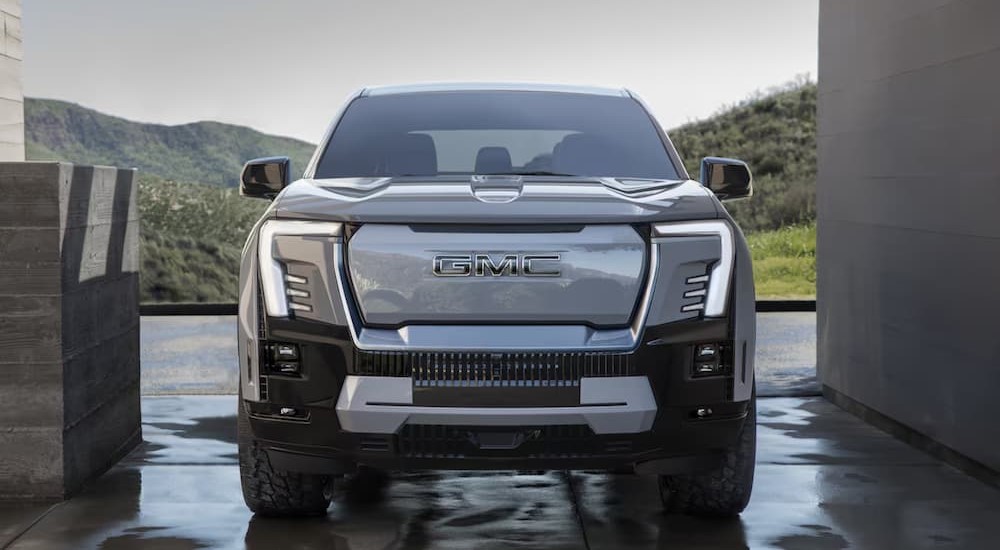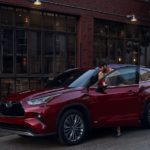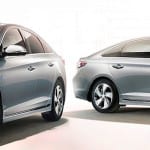The EV market has certainly been on the upswing in the decade and a half since the Tesla Roadster and Nissan LEAF first hit the market, with a record 1.1 million EVs sold in 2023 alone. That represents a staggering 46% increase over the previous year, but the transition to the all-electric segment hasn’t always been easy. While many automakers have announced ambitious goals related to EV production, the reality is starting to set in.
GM, in particular, seems to have begun backtracking. The legacy brand made a commitment to sunset all gas-powered vehicle production by 2035 to go all-in on EVs. However, in a recent conference call with investors, GM CEO Mary Barra made a dramatic about-face and said that hybrid models––not all-electric vehicles––will play a larger role in the company’s short-term plans. This might seem like a step in the wrong direction to EV enthusiasts, but it begs the question: what does GM’s announcement of new hybrid models mean?
While details on the specific hybrid models in question are still a little hard to come by, it’s worth examining GM’s decision to see what it means for the EV segment as a whole. Did the industry simply bite off more than it can chew? Is consumer demand not meeting expectations? Are these just some minor bumps in the road towards an all-electric future? We’ll explore all that and more as we take a closer look at GM’s hybrid hesitation.
Barra of Bad News
We’ll start with Barra’s announcement, which came as part of GM’s Q4 2023 earnings call with investors. “Our forward plans include bringing our plug-in hybrid technology to select vehicles in North America,” said Barra in late January. The CEO cited the current state of the nation’s EV charging infrastructure as part of the reason for the abrupt shift, suggesting that it might be more of a hurdle toward widespread EV adoption than originally anticipated.
“Let me be clear: GM remains committed to eliminating tailpipe emissions from our light-duty vehicles by 2035. But in the interim, deploying plug-in technology in strategic segments will deliver some of the environmental benefits of EVs as the nation continues to build its charging infrastructure,” she said.
EV charging infrastructure, along with EV affordability and range, are often cited as the top three factors that are keeping drivers from embracing the new technology. The country’s charging infrastructure has come a long way in recent years and doesn’t look to be slowing anytime soon, with the number of public EV charging stations increasing by approximately 50% in the last year alone.
The GM CEO cited tightening emissions standards as another major driver in the decision. “We are timing the launches to help us comply with the more stringent fuel economy and tailpipe emission standards that are being proposed,” Barra said. By hybridizing some of its current gas-powered models, GM can meet the new standards while sidestepping the cost, logistics, and marketing issues common to the all-electric segment. Today’s drivers are simply too accustomed to the traditional internal combustion engine (ICE) formula, but hybrid models could be a good way to bridge the gap until EV acceptance is more widespread. “We’re building on a foundation that our customers love,” said Barra.
While GM has yet to reveal any specific makes and models that are slated for a hybrid makeover, Barra said GM will target “key segments” as part of the push. Given their popularity, some experts believe GM’s full-size pickups will be the first to get the hybrid treatment, with Sam Fiorani of AutoForecast Solutions citing the Chevy Silverado and GMC Sierra as likely candidates. “Needing to balance out the big V8s in the pickups and SUVs, GM is likely to target the hybrid and plug-in models from Ford, Toyota, and Ram,” says Fiorani.
The Hybrid Advantage
This isn’t the first time that GM has backed away from its ambitious EV plans. In late 2023, the company reneged on its goal of producing 400,000 EVs by mid-2024, signaling that the company was having second thoughts about the segment. The move towards hybrid models seems to confirm that suspicion. GM has also delayed the introduction of new EV models like the Chevrolet Equinox EV, Chevrolet Silverado EV, and GMC Sierra EV and abandoned plans to invest $5 billion in developing new entry-level EV offerings with Honda. One bright spot is the Chevy Bolt EV, which is being redesigned with a more affordable lithium-iron-phosphate battery that should keep the model well within reach of the average driver.
While EVs are the obvious solution when it comes to meeting emissions standards, the all-electric models present some real challenges that make them an unrealistic option in the short term. While the difficulty of sourcing lithium batteries and turning a profit on the tech-heavy EVs certainly plays a role, the biggest hurdle seems to be driver acceptance. Hybrids are simply a more flexible option for most drivers. Making the jump to the all-electric lifestyle might pay dividends in terms of efficiency and lifetime ownership costs, but it can still be something of a hassle in the short term as drivers struggle to acclimatize to the platform’s idiosyncrasies and inconveniences.
Plug-in hybrids represent an alluring middle ground for those not ready to make the jump to the all-electric lifestyle. With a gas engine supplementing the models’ electric motors, drivers don’t need to worry about topping off the battery, range anxiety, or the diminished range that can come with colder temperatures. Sure, EV sales have been on a steady upswing in recent years, but hybrids have also been on the rise. In fact, the segment posted record sales in 2023, with more than 250,000 plug-in hybrid vehicles sold. That might represent less than a quarter of the EV market, but businesses like GM tend to focus on trends, not just pure numbers when trying to forecast the future.
GM has missed out on the hybrid segment’s record growth, having discontinued all of its hybrid models back in 2019 to focus on EVs. It might have seemed like the right move at the time, but now it looks like a missed opportunity that could put GM at a serious disadvantage as many of its competitors––particularly Toyota, the world’s largest automaker––never gave up on hybrid and plug-in hybrid offerings. GM’s only current hybrid is the new 2024 Chevy Corvette E-Ray, and with a price tag that’s north of $100,000, the sports car is certainly not going to drive a lot of sales.
Testing Volt-age
The road to an all-electric future isn’t without its detours. When ileSebring-Vanguard introduced the CitiCar EV in the mid-1970s, the model’s success allowed the company to grow into the country’s sixth-largest automaker, though a limited range of just 40 miles would see this early electric model quickly fade from the public consciousness. Tightening emissions regulations would see the segment make a comeback in the late 1990s with GM’s EV1, but it was actually a hybrid model that truly got the ball rolling. The Toyota Prius burst onto the scene at the turn of the millennium, instantly turning heads with its unique styling and whisper-quiet operation. Celebrity endorsements helped to raise the hybrid’s profile, making the Prius an overnight icon on the path to electrification.
Hybrids would be joined by all-electric models as the 2000s unfolded, with ambitious EV startup Tesla unveiling the Roadster in 2006. The company’s success would inspire major automakers to explore electric vehicles in earnest, with GM leading the way. In fact, the brand would roll out the industry’s first mass-produced plug-in hybrid with the debut of the Chevy Volt in 2011.
The Volt was a real success story in its time, combining a gas-powered engine with a large lithium-ion battery to give drivers the best of both worlds. The car’s nine-gallon gas tank offered some impressive flexibility, but it was the 16 kWh battery and 35 miles of electric range that marked its biggest selling point. Despite hitting the market more than a decade ago, the Volt actually surpasses many modern plug-in hybrids when it comes to all-electric range.
Unfortunately, it seems the Volt was a little ahead of its time. Sales were slow, with Chevy moving just over 150,000 units in a nine-year run. It might have whetted the driving public’s appetite for hybrid and electric vehicles and worked as a solid proof-of-concept, but GM gave up a little too early and now seems to be left playing catch-up.
GM’s renewed focus on the hybrid segment might help the company weather the current market, but some proposed regulations from the EPA could force automakers to shift to all-electric vehicles in the near future. One potential rule would require all brands to shift two-thirds of their production to EVs by 2032, though many companies are actively lobbying against a timeline that they call unrealistic.
What Does the Future Hold?
Plug-in hybrids might be a good stopgap, but they’re probably not the future of the industry. Increasingly strict government regulations, along with increased competition from Chinese automakers, will likely push the American auto industry into its all-electric era before too long, though the exact timeline is still a bit hazy. GM might have made some missteps in its EV plans, but with 115 years of success to its name, the automaker has a track record when it comes to weathering changing market conditions.
While backtracking on an established plan is never a good look, one has to give GM some credit for responding to the situation rather than doubling down on its all-electric goals. The company’s forthcoming hybrid models should not only help to meet current customer demands but also double as a way of helping drivers adjust to certain EV-related quirks like charging without throwing them in the deep end. In a perfect world, GM might have followed Toyota’s lead and put more of an emphasis on hybrids before making the jump to full-fledged EVs, but with so many companies racing to become the leader in the EV segment, these sorts of detours are bound to happen.




